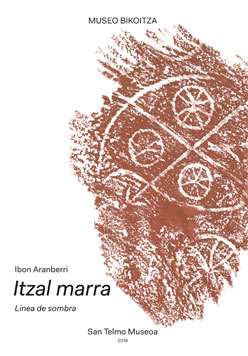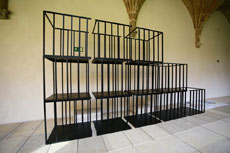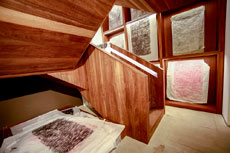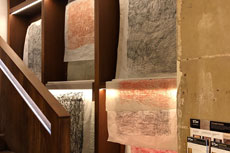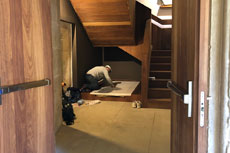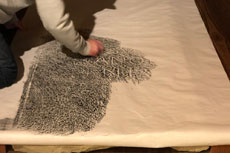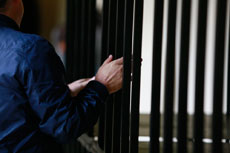- Home
- Exhibitions
- Museo Bikoitza
- Ibon Aranberri, 2018/19
Ibon Aranberri, 2018/19
Itzal marra (Shadow Line)
In this opening edition, Ibon Aranberri has created a double installation comprising materials and strata unearthed from the museum’s displaced collections. Under the title Itzal marra (Shadow Line), on the one hand it rebuilds a manufactured structure as a storage system. On the other hand, it presents a complete collection of tracings generated from the inscriptions of found surfaces.
Here, Ibon Aranberri explains his project:
"When it was turned into a museum, the old convent was transformed into a functional infrastructure adapted to public service. As a project arising from industrialisation, it began the task of conserving materials and vestiges of the ways of life undergoing changes, with a mission to organise a cultural story meeting the needs of modern society.
Over time, the collection has undergone further reviews until it has taken on the condition of a didactic inventory open for consultation. Thus, the museum has moved towards dematerialisation, to the extent that identification does not necessarily involve physically touching the item, but rather gaining access to its traces. This movement has allowed the interior architecture to be emptied, preparing it in accordance with new uses.
The structure has been recovered and extended, retaining the marks from its disassembly to serve as instructions for its future reassembly, something which never happened.
In parallel, the usual storage spaces have been relocated. Today, these warehouses constitute the exteriority of the museum itself. A large part of the materials accumulated there come from previous uses and situations. Through sharing the same compartment, the differential limits between classical categories such as heritage, collection and material culture end up dissolving into each other.
The refurbishment generated its own heritage surplus, by renewing or altering its environment. Some of the objects which came to the surface are from components of the building itself. Different emergency digs carried out underground led to the discovery of new pieces. These remains were gathered together, until they attracted other similar items. The final gathering cuts through different historical phases of the museum and constitutes one of its distinguishing features. Among the materials are an abundance of gravestones, taking up a considerable amount of storage space. The majority come from the museum’s own past and burials in neighbouring churches. On slabs of worn sandstone, surnames of merchants from centuries gone bay appear repeatedly. These have been transferred to the museum as a repository of the city’s legacies, as forms of burial have evolved.
To begin with, the gravestones on exhibition kept their horizontal orientation, slightly raised from the ground, thus showing their original position. Due to widespread museum policies, which prioritise circulation above contemplation and promote visual perception, these gravestones have been elevated to a vertical position, freeing up space and putting forward a frontal approach. In this process, the three-dimensional body ends up reduced to a flat surface.
The tracings mark and reveal the inscriptions contained by the surfaces covered by paper, as well as blurring their image
A modular metallic structure, made to measure in the past as a gravestone storage system. It is a centralised system model, from when storage co-existed with other museum environments, before the outsourcing of services. The structure has been recovered and extended, retaining the marks from its disassembly to serve as instructions for its future reassembly, something which never happened. It is now presented as a free-standing shape which has been transferred to the exhibition space.
Meanwhile, the gravestones in the museum’s new storage space open to the public have been subjected to different tracing techniques, generating multiple images. They remain hidden beneath their representation. The tracings mark and reveal the inscriptions contained by the surfaces covered by paper, as well as blurring their image. In the interest of completeness, tracings of units and fragments stored elsewhere in auxiliary warehouses have been included. Tracings have also been made of gravestones which, coming from underground in the museum, were in the custody of other competent bodies, having been classified as archaeology.”
Ibon Aranberri
He studied Design and Sculpture at the University of the Basque Country (UPV) and at the Polytechnic University of Milan. Following this, he undertook research and worked in different places in New York and Japan. Since then, he has carried out a great many projects all around the world. Occasionally, he has taken teaching assignments in different schools and has collaborated with print media.
ome of the exhibitions he has organised in recent years are as follows:
- 2017 Common Practices, Isabella Bortolozzi Galerie, Berlin, Alemania
- 2016 Suzhou Documents: Histories of a Global Hub, Suzhou Art Museum, China
- 2014 Finite Location, Secession, Viena, Austria
- 2012 Garden of Learning, Busan Biennale, Busan, Corea del Sur
- 2011 Organigrama, Fundació Antoni Tapies, Barcelona,
- 2010 Gramática de meseta, Museo Nacional Centro de Arte Reina Sofía (MNCARS), Madrid.
- 2008 Revolutions – Forms that Turn, 16a Bienal de Sydney, Australia
- 2007 Integration, Kunsthalle Basel, Basilea, Suiza
- 2007 Documenta 12, Kassel, Alemania
- 2002 Manifesta IV, Frankfurt
In September 2019, he will take part in the Biennale of Gothenburg
Inglés
Aprende a pronunciar
Artist chosen for the next edition: Erlea Maneros Zabala
Following the methodology of Museo Bikoitza, Aranberri has chosen the artist who will participate in the second edition of this program: Erlea Maneros Zabala.
Among other reasons, he has chosen Erlea because the research carried out and techniques used during her career are adapted to the complexity of the museum, for her ability to create new imaginations relating different threads and files, and because her vision of the museum from a distance (she lives in abroad) will enrich the result.
WEB HEADER:
PAGE FOOTER:
Auxiliary menu:
San Telmo Museoa. 2024 copyright ©
HELP WHIT SURFING:
